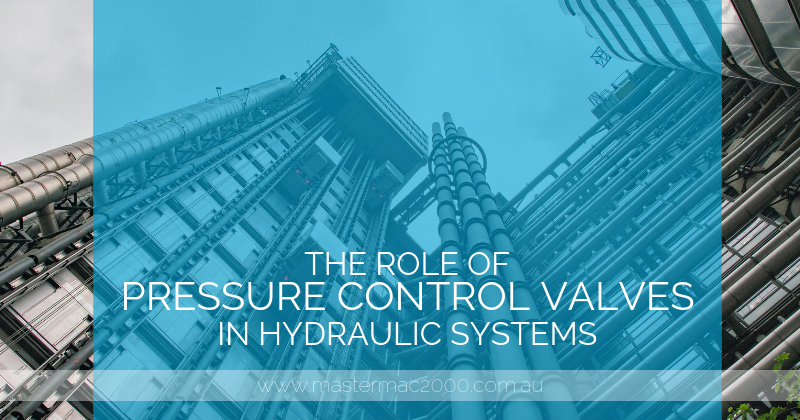The Role of Pressure Control Valves in Hydraulic Systems

In hydraulic systems, hydraulic energy is produced as there is a prime mover, generally an electric motor, driving the pump. This develops hydraulic pressure due to resistance to the flow of the pump. However, if the pump flow is off-loaded, recirculated back to the tank, or brought to a stop during the circuit’s non-action periods, the hydraulic system gets damaged. These non-action periods happen during time-delay periods of the sequence of the circuit, the end of the circuit sequence or the stroke, or actuator delay.
How to avoid damage in the hydraulic system?
Circuit designers utilise cleverly-designed systems to control the pump flow and maximum system pressure during non-action periods, so as to avoid overheating of the hydraulic fluid, power wastage, and hydraulic system damage. Through the use of a pressure control valve, the actuator force is controlled, and pressure levels are determined. Here are other system functions of pressure controls:
- Assist actuators’ sequential operation in a circuit
- Limit maximum system pressure at safe levels
- Reduce pressure levels from the main circuit to a lower pressure
- Regulate or reduce pressure in specific portions of the circuit
- Unload system pressure
How do various types of pressure control valve work in hydraulic systems?
There are four different types of valves, and their identifications are based on their functions in the circuit.
Counterbalance valve protects the hydraulic system from line failure, pressure shocks, enables free flow in one direction, and many other functions.
Pressure-relief valve limits the ceiling pressure in a hydraulic circuit by creating an alternate path for fluid flow when preset pressure level is reached. It protects the system from having excess pressure as what is required in all fixed-volume pump circuits. Relief valves are important when actuators stall with the still-in-shifted-position directional valves.
Relief valves can be compared to a fuse in an electrical system. It protects the system from the excess current by keeping it below the preset level.
Utilised in maintaining reduced pressures in parts of hydraulic systems, the pressure-reducing valves are actuated by the pressure flowing downstream that tends to close as it reaches valve setting. They usually come with a check valve to enable reverse free flow.
The unloading valve is used to dump excess fluid to the tank, with little to no pressure. It is usually applied in high-low pump circuits, where there are two pumps that move an actuator at low pressure and high speed. This lets the circuit shift to a single pump, giving off high pressure to do the work.
Unloading valves also function in sending excess flow coming from a retracted oversize-rod cylinder’s cap end to the tank. A smaller and less-expensive directional control valve can be used in this process while keeping a low-pressure drop.
If you think we missed to cite some other types of pressure control valve, comment down below.

About MasterMac2000: Your Trusted Pneumatic & Process Automation Partner.
LEADING THE INDUSTRY: Established in 1989, MasterMac2000 has grown to become one of Australia's largest privately owned pneumatic and process automation companies. We stock top-quality brands like Univer, Mack, Tolomatic, Mac, Piab, American, and Rotoflux in Brisbane.
SERVING QLD & NORTHERN NSW: We proudly service Queensland and Northern New South Wales for all your pneumatic and process equipment needs. Our mission is to provide the best pre and post-sales support while actively expanding our client base.
SOURCING HARD-TO-FIND PARTS: Not only do we stock quality components, but we also excel at sourcing those elusive, hard-to-find parts. With our extensive database and global network of contacts, getting the parts you require is as easy as a call to our highly skilled, professional sales team.
DEDICATED TO YOUR SUCCESS:
- Decades of expertise in pneumatics & process automation
- Carefully curated selection of world-class brands
- Exceptional sourcing capabilities for speciality parts
- Knowledgeable sales staff dedicated to finding solutions
- Unwavering commitment to customer service excellence
About The Author
Stuart Havill
Stuart Havill is the owner and manager of MasterMac2000, Queensland's largest privately owned pneumatic and process valve company.
With his early working career as a maintenance fitter for Boral in 1992, Stuart has spent his life in the field of pneumatics and process equipment. He gained extensive experience in plant design, maintenance, repairs, fabrication, and site management.
In 1996, he transitioned to a pneumatic sales technician role at MasterMac2000, where he excelled in key account management, providing cost-effective solutions, and managing a sales team of 9 employees.
Since 2002, Stuart has been the manager at MasterMac2000, overseeing the company's growth and establishing it as a leader in pneumatic automation and process valve engineering. His expertise spans customer training, CRM setup, industrial compressor sizing and installation, and turn-key project management.
Under Stuart's leadership, MasterMac2000 has been servicing the industry since 1988, with 5 full-time sales representatives covering northern rivers NSW, Queensland, Northern Territory, and PNG. The company prides itself on providing the best-priced solutions to all customers in the marketplace.
View Stuart’s LinkedIn profile to learn more about his expertise in pneumatics and process equipment.